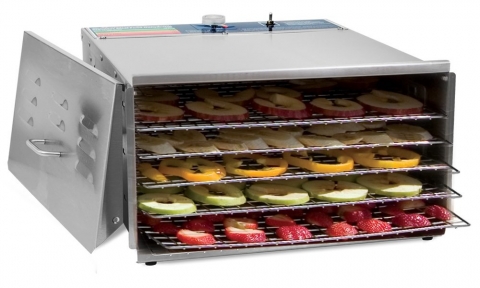
All food dehydrators share a common goal: to remove most of the water from the food they are used to dehydrate in an efficient manner. To accomplish this goal, a good food dehydrator needs to deliver a constant temperature and even airflow across all trays. Modern electric dehydrators do this with a thermostat, a heating element, and a fan that circulates fresh heated air evenly.
There are some economy dehydrators that don’t use a thermostat or fan, but we recommend that you avoid these machines, as they generally do not provide the performance needed to dry foods in a reliable, predictable fashion. For the purpose of this article, we’re going to focus only on electric dehydrators that have fans and thermostats.
There are two basic kinds of dehydrators, those that use trays that are stacked on each other, and those that use shelves as trays that slide into a box. Each design has some advantages and disadvantages, as we will see.
Stacking dehydrators
Stacking dehydrators have trays that stack snugly on top of one another. They have a fan mounted either in their base, or, in a power unit that sits atop the stacked trays. The trays themselves have a hole in the center that forms a core channel through which air is routed. Heated air is forced up along the outside walls and then across each tray to the center channel where it exits the machine. This design allows air to move evenly across all trays, and generally makes it unnecessary to rotate trays while drying.
A key benefit of stacking dehydrators is their flexible and efficient capacity. Because you can add or remove trays to accommodate both small and large batches, the volume inside a stacking dehydrator is matched to the amount of food you are dehydrating. In addition, the larger stacking models can handle a lot of trays. The NESCO 1018P, for example, can use up to 30 trays, for a total maximum drying area of 30 sq. ft. Stacking tray models do require you to stack and un-stack trays as you check progress and move trays around. You can’t just slide out the second tray from the bottom to see how it’s doing – you’ll need to un-stack it.
Shelf dehydrators
The other main kind of dehydrator is a “shelf” dehydrator. With shelf-type dehydrators, the trays of the dehydrator are shelves that slide in and out of a box. These dehydrators have a different airflow system. Usually the fan and heating elements are mounted in the rear of the unit, and blow air horizontally across the shelves toward the front. This design promotes even drying, so that the trays do not need to be rotated.
Because the box shape of a shelf dehydrator limits the number of trays that can be used, the capacity of a shelf model isn't as flexible as a stacking tray machine. However, shelf units have their own advantages. For example, like an oven, you can remove some trays when you need to dry bulky items, and you don't have to un-stsck trays to access one particular tray. Also, unlike stacking dehydrators, shelf dehydrators don’t have a hole in the middle of each tray. As a result, it’s easier use the entire tray, especially when making things like fruit leathers or raw crackers.
Fan and airflow system
Better food dehydrators will have a fan, a heating element, and a design that facilitates even airflow across all trays. The size and power of the fan and heating element varies with the model. Typically, fans range from about 4” to 7” in diameter. Depending on size and capacity, a dehydrator will use 300 to 1000 watts of power. A few units, like the Sedona SD-9000 have dual fans.
Note that the fans on some dehydrators are quite loud – comparable to, say, the exhaust fan above a stove. Consider this when you think about where you will run your dehydrator.
Adjustable thermostat
One of the most important features of a modern dehydrator is an adjustable thermostat that can be used to set and maintain an even temperature. A typical range an adjustable thermostat is 95 to 155 degrees Fahrenheit. This is important, because the recommended settings for each major food type vary quite a lot. As an sample, the temperatures below are printed on Excalibur dehydrators.
Capacity
One of the biggest differences between food dehydrators is capacity. Smaller dehydrators will have 3-4 square feet of drying capacity. Medium sized units, like the 5-tray Excalibur 3500, will have about 5-9 sq. ft. of drying area. Large units will have 10 sq. ft. or more. For example, the Excalibur 3900 comes with 9 trays that each provide 1.7 sq. ft. of drying area, giving a total drying area of 15 sq. ft. Stacking dehydrators provide a broader range. For example, the NESCO 1018P Gardenmaster comes with 8 trays that provide 8 sq. ft. of drying area total. However, the NESCO 1018P can accept up to 30 trays, which gives it a maximum capacity of 30 sq. ft.
Although 3 or 4 sg. ft. may sound like a lot of space, keep in mind that you often may want to dehydrate in larger batches, especially during harvest season, or when you find something on sale. You'll be surprised at how fast you fill up the shelves. For example, you can fill up a large tray easily less than a half-pound of sliced strawberries. If you think you might be doing a lot of dehydrating, you will probably want 10 sq. ft. or more. Read more about dehydrator capacity here.
Note: May dehydrators are quite large and will take up a lot of counter space if you choose to operate them in your kitchen. If you have the option to put the dehydrator on an outside deck or porch, or in an unused room, you can keep your kitchen clear and avoid the fan noise.




Comments
?
What's the name of the dehydrator from the picture?
TSM Stainless Steel
TSM Stainless Steel Dehydrator with 5 Stainless Steel Shelves
http://www.dehydratorreview.net/reviews/tsm-stainless-steel-dehydrator-5...
Lisa
Wattsge
Does a higher wattsge mean less drying time
Wattage
I have that exact same question. Hopefully it gets answered soon. I am now pretty well educated as to the one out of the 3 I have done my research on. But wattage is the biggest question I need an answer too. Great question btw
Wattage
So after asking Google for the exact right question I finally got out answer the lower the wattage the less energy used....witch I knew but in the dehydrator world the longer it takes to heat up. The higher the wattage to more energy it uses....again we know. But it heats up your dehydrator up much for faster. But the higher wattage it becomes much more expensive to buy and to run.....Bam! Googles you can't stump me I just need to ask the right question in the right way 20 times lol. But thats the answer to our prayers and questions. So from what I gather the wattage falls on the users preference. Lower watt longer time less over head higher watt shorter time more energy drawn usage . User preference.
Wattage
You missed one point. Machines do not use same wattage all the time upon it reaches appropriate temperature. Hence, lower wattage means it has to run at its full capacity all the time to maintain high temperature while higher wattage machine reaches its temperature faster and maintain the temperature with lower wattage used. This applies same when you put more food to dehydrate (a/k/a capacity). Long story short, it might be cheaper in the long run with high wattage machine.
Thank you, T
Your comment in regard to lower wattage costing more in the long run helped me tremendously. I am wanting to buy this for using a lot. I had one I used once when younger (because I did not know how & gave up). I now can find resources such as you. Thank you!
Wattage
Wattage needed is dependent upon size of load, % of water to be removed, the insulation factor of the unit, the airflow through the unit, and the temperature setting of the temperature controller. Thus a higher wattage element will bring the operating temperature to setpoint quicker. However, there is the consideration of air flow through the unit. The air flow must be balanced with the wattage used so that the temperature is kept constant and at setpoint. Using a controller with ON/OFF control (with low deviation offset) will show a higher percentage ON time with a higher dehydration load. This should not be a high percentage. Balancing all these variables to the operators preferences can be a 'getting to know you" learning experience.
Wattage
So after asking Google for the exact right question I finally got out answer the lower the wattage the less energy used....witch I knew but in the dehydrator world the longer it takes to heat up. The higher the wattage to more energy it uses....again we know. But it heats up your dehydrator up much for faster. But the higher wattage it becomes much more expensive to buy and to run.....Bam! Googles you can't stump me I just need to ask the right question in the right way 20 times lol. But thats the answer to our prayers and questions. So from what I gather the wattage falls on the users preference. Lower watt longer time less over head higher watt shorter time more energy drawn usage . User preference.
Add new comment